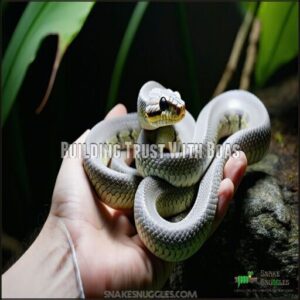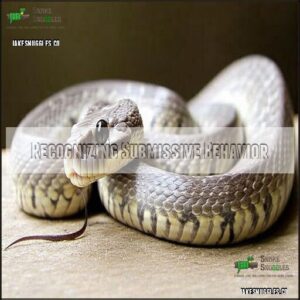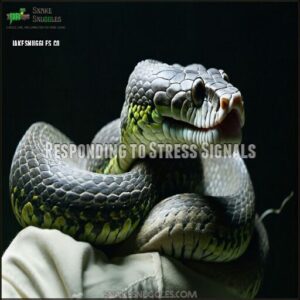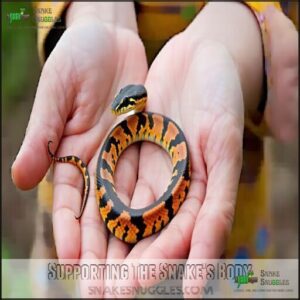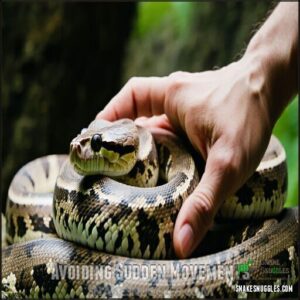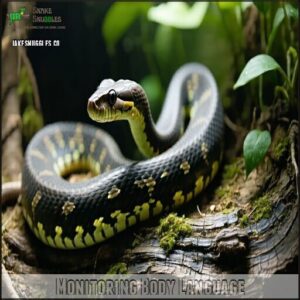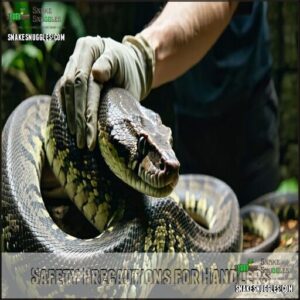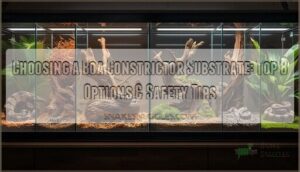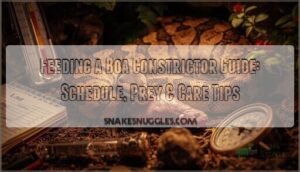This site is supported by our readers. We may earn a commission, at no cost to you, if you purchase through links.

First, identify stress signs like tight coiling, hissing, or defensive striking. Approach your snake from the side rather than above (they hate feeling like prey).
Support your boa’s entire body weight, using a snake hook if necessary. Never handle during shedding or after meals—that’s asking for trouble.
Keep movements slow and deliberate; quick gestures can trigger defensive reactions faster than you can say "fangs a lot." Maintain a consistent handling routine to build trust, just like training a puppy—except this puppy can squeeze the dickens out of your arm when startled, which requires a steady hand.
Table Of Contents
- Key Takeaways
- Handling Stressed Boas
- Choosing Right Handling Time
- Building Trust With Boas
- Managing Boa Constrictor Behavior
- Handling Techniques for Boas
- Safety Precautions for Handlers
- Frequently Asked Questions (FAQs)
- How to tell if a snake is stressed when handling?
- How to handle an aggressive boa constrictor?
- How do you calm a nervous snake?
- What to do if a boa is constricting you?
- Can boa constrictors recognize their owners?
- How often should I handle my boa?
- Do boas prefer male or female handlers?
- Can music calm a stressed boa constrictor?
- What temperature is ideal during handling sessions?
- Conclusion
Key Takeaways
- Watch for stress signs like tight coiling, hissing, or rapid tongue flicking, and approach calmly from the side to avoid triggering defensive behavior.
- Always support the snake’s full body evenly with both hands and use slow, deliberate movements to prevent startling it.
- Don’t handle your boa during shedding or right after meals—these are stressful times that can lead to defensive reactions or health risks.
- Build trust gradually by maintaining a consistent, gentle handling routine and paying close attention to your snake’s body language.
Handling Stressed Boas
When handling a stressed boa constrictor, it’s important to recognize signs like hissing, tail whipping, or muscle tension.
By approaching the snake calmly and using proper tools like a snake hook, you can make the process safer and less stressful for both you and the boa.
Recognizing Stress Signs
Recognizing snake stress signs is key to keeping your boa comfortable.
Watch for defensive coiling, rapid breathing, or muscle tension—these are signals of boa constrictor anxiety.
Look for pupil dilation or exaggerated tongue flicking, both common stress signs.
If your snake hides its head or stays immobile, it’s likely feeling overwhelmed.
Always adapt to their snake behavior cautiously.
Approaching The Snake
Approach a stressed boa constrictor calmly and carefully to avoid escalating stress. Secure the area, ensuring no escape risks.
Approach with calm confidence—rushed movements only amplify your boa’s anxiety and defensive responses.
- Wash your hands to remove scents that could confuse the snake.
- Use slow movements, observing the boa’s body language.
- Introduce a snake hook gently for familiarity.
Consider how enclosure size matters to reduce stress.
- Avoid sudden actions that trigger defensive snake handling signals or startle the boa, ensuring a safe and stress-free environment.
Using a Snake Hook
When handling a stressed boa constrictor, a snake hook is a reliable companion.
Start by selecting quality snake handling tools with sturdy hook material. Use a gentle hook angle to avoid alarming the snake.
For safe hooking, place the hook just forward of the middle and lift steadily. A suitable option is a boa constrictor hook designed for reptile safety.
If needed, consider hook alternatives like padded tongs for better control and safety.
Choosing Right Handling Time
Choosing the right time to handle your boa constrictor helps reduce its stress and guarantees a safer interaction.
Avoid times when the snake is shedding, digesting, or overly active to prevent unnecessary discomfort or defensive behavior.
Avoiding Shedding Periods
Shedding irritability is common, making snake handling risky during this time.
Recognizing shed signs, like duller scales or cloudy eyes, helps avoid unnecessary handling risks.
Increased humidity impacts their comfort, aiding in reptile stress reduction.
Post-shed handling is safer, as stress relief occurs naturally.
Give your boa space during snake shedding to preserve calmness and guarantee minimal snake stress relief efforts later.
Waiting After Feeding
After shedding, feeding is another time when boa constrictors need space.
Handling right after a meal can lead to regurgitation, stress, or even harm from a disturbed food bolus.
To keep your snake comfortable, wait at least 48 hours.
Here’s why:
- Digestion demands energy.
- Regurgitation risk rises with movement.
- Fullness lowers activity levels.
- Handling avoidance prevents harm.
- Rest guarantees health.
Handling at Night
Nighttime handling works best when your boa is calm and alert.
Use dim lighting to avoid startling it, and keep noises minimal—snakes stress easily.
Handle briefly to maintain reptile stress reduction, building trust gradually.
Always check enclosure security afterward, combining careful snake handling techniques with awareness of boa constrictor behavior to guarantee a smoother experience when calming a snake at night, which helps in building trust.
Building Trust With Boas
Building trust with your boa constrictor takes time, patience, and consistent effort.
By handling gently and creating a predictable routine, you can help your snake feel secure and more comfortable with interaction.
Gentle Handling Techniques
When calming a snake, start with a gradual introduction. Approach slowly with calm movements, supporting its body evenly—this Proper Support builds trust.
Avoiding the head minimizes reptile stress reduction. Stick to short sessions of five to ten minutes, as longer handling can overwhelm them.
These snake handling techniques promote snake handling stress reduction while ensuring a gentle handling experience, which is crucial for a positive interaction with the snake, and gentle handling is key to this process.
Consistent Handling Routine
Creating a predictable schedule is key to reducing a stressed reptile’s anxiety.
Gradual exposure helps boas feel at ease, so stick to consistent snake handling routines.
Keep session lengths short at first, increasing over time to build trust.
Routine benefits include familiarity and positive associations, and reducing stress requires both patience and steady commitment.
Positive Reinforcement
To build trust with a stressed reptile, use positive reinforcement during snake handling.
Here are five tips for success:
- Reward calmness with gentle praise and slow movements.
- Try clicker training or target training with food association.
- Avoid startling; approach confidently.
- Handle during calm moments to establish trust.
- Watch for stress, and end on a calm note.
Snake owners can find clicker training supplies online.
Managing Boa Constrictor Behavior
When managing your boa constrictor’s behavior, understanding its body language is essential for reducing stress and preventing defensive reactions.
By recognizing signs like defensive postures or submissive movements, you can adjust your approach to create a calmer, safer interaction.
Identifying Defensive Postures
Now that you’ve established trust with your boa, learning to read its defensive postures is your next skill to master.
Watch for the classic "S" shape in your boa’s body—this coiled position with a raised head signals readiness to strike.
Rapid tongue flicking, muscle tension, and rigid hovering movements indicate your snake feels threatened.
Understanding these snake defense mechanisms helps prevent bites and reduces stress during handling.
Recognizing Submissive Behavior
When your boa displays submissive behavior, you’ll notice several calm indicators that signal trust.
Look for relaxed postures such as loose coiling, a gently resting head, and slow movements without defensive behavior. The snake’s body language speaks volumes—a lack of muscle tension and smooth, deliberate exploration suggests comfort.
Unlike stress coiling or defensive positions, these trust signals indicate your boa feels secure in your presence.
To further guarantee safety, remember to implement consistent tap training before handling, ensuring a safe and trusting environment for both you and your boa.
Responding to Stress Signals
Just as you’ve learned to recognize submissive postures, you’ll need to respond appropriately when your boa displays stress signals.
When you notice rapid tongue flicking, muscle tension, or hissing, immediately stop handling and provide a safe retreat.
Create a calm environment by dimming lights and minimizing movement.
Gradual desensitization helps reduce defensive behavior over time.
Remember, interpreting signals correctly is key to stress management and preventing threat responses during snake handling.
Handling Techniques for Boas
You’ll need to support your boa’s body properly when handling, using both hands to distribute weight evenly while avoiding sudden movements that might trigger defensive behavior.
Watch for signs of stress in your snake’s body language, such as rapid tongue flicking or muscle tension, so you can adjust your technique accordingly.
Supporting The Snake’s Body
Proper body support forms the foundation of safe snake handling.
When holding your boa, distribute its weight evenly across both hands and arms to prevent spinal damage.
Never dangle any portion of your snake—this risks serious injury.
Maintain a secure grip that’s firm but gentle, allowing natural movement while ensuring the boa feels stable.
Remember, proper spinal support reduces stress coiling and creates a more positive handling experience for both of you.
Avoiding Sudden Movements
Avoiding sudden movements is key to safe snake handling and keeping your boa at ease.
Use a calm approach and predictable movements to reduce stress.
Follow these tips for snake handling safety:
- Move slowly, avoiding jerks.
- Use smooth shifts when repositioning.
- Place the snake down gently.
- Watch for snake handling stress signs, like hissing.
Remember to wash hands thoroughly before handling your boa to ensure a safe and healthy environment for both you and your boa.
Monitoring Body Language
Just as avoiding sudden movements keeps your boa calm, reading its body language is your key to safe handling.
Watch for stress signals that tell you when to back off.
| Body Language | Meaning | Your Response |
|---|---|---|
| Rapid tongue flicking | Anxiety or stress | Reduce handling time |
| Tense, rigid muscles | Defensive posture | Support body better |
| Relaxed, slow movements | Submissive behavior | Continue gentle handling |
| Head pulling back | Fear indicator | Give space, avoid head |
Safety Precautions for Handlers
Handling a stressed boa constrictor safely starts with preparation and awareness to avoid accidents.
By washing your hands, using proper restraint techniques, and ensuring secure handling areas, you can protect both yourself and the snake, which is crucial for safe handling.
Washing Hands Thoroughly
The invisible threat of bacteria lingers on your hands before reptile handling.
Always wash with antimicrobial soap for at least 20 seconds, using warm water temperature to effectively kill germs. Your scrubbing duration matters—clean under nails and between fingers thoroughly.
Proper drying methods (paper towels, not cloth) prevent Salmonella and disease transmission.
Don’t skip this step when handling your boa constrictor; hygiene isn’t optional, it’s essential for both your safety.
Using Proper Restraint
Now that your hands are clean, mastering a safe grip is your next priority.
When handling your boa, always use a loose restraint technique that allows natural movement while maintaining control.
Support the snake’s body evenly with both hands, never picking it up by its tail which can cause spinal damage.
Consider using specialized protective gear for added safety.
Keep the neck area protected and monitor your boa’s body language for signs of discomfort during restraint to prevent injuries during snake handling.
Avoiding Escapes and Injuries
Security breaches happen in seconds when handling boa constrictors. You’ll need secure enclosures with double-checked latches before and after handling sessions.
Create a handling environment free from hiding spots and escape routes. For escape prevention, block doorways and vents during handling time.
Watch for danger signs like rapid movements indicating the snake feels unsafe. Always have emergency protocols ready—including bite management procedures—to guarantee both your safety and your pet’s well-being.
Always use puncture-resistant handling gloves to minimize risks.
Frequently Asked Questions (FAQs)
How to tell if a snake is stressed when handling?
John noticed his boa’s rapid tongue flicking and tense muscles during handling.
You’ll know your snake is stressed when it exhibits quick movements, hissing, tail rattling, defensive posturing, or attempts to escape your grasp, which can include rapid tongue flicking.
How to handle an aggressive boa constrictor?
Stay calm and approach the boa from the side, using a snake hook to gently guide it.
Avoid sudden movements, support its body evenly, and keep sessions brief.
Patience is key to reducing aggressive behavior.
How do you calm a nervous snake?
Wondering why your snake seems on edge?
Move slowly, maintain regular handling sessions, reduce environmental stimulation, and give your snake time to adjust.
You’ll build trust gradually with consistent, gentle interactions.
What to do if a boa is constricting you?
If a boa is constricting you, unwind it starting from the tail, not the head.
Don’t pull or yank.
If possible, submerge its head in water to make it release its grip immediately.
Can boa constrictors recognize their owners?
Your boa may recognize you by your scent and handling patterns but doesn’t form emotional attachments.
They can distinguish between familiar and unfamiliar handlers, responding differently based on previous interactions and experiences.
How often should I handle my boa?
Did you know that 95% of boa owners handle their snakes 1-3 times weekly.
You should handle your boa for 10-15 minutes, 2-3 times weekly, allowing rest days between sessions to minimize stress.
Do boas prefer male or female handlers?
Boas don’t actually distinguish between male or female handlers.
They respond to gentle, confident handling techniques rather than gender.
Your consistent approach and body temperature matter more than whether you’re male or female.
Can music calm a stressed boa constrictor?
Music’s melodious magic won’t miraculously calm your stressed boa constrictor.
They can’t hear airborne sounds well but may sense vibrations.
You’ll have better success with gentle handling, proper temperature, and a quiet environment.
What temperature is ideal during handling sessions?
You’ll want to maintain a room temperature between 78-85°F during handling sessions.
This range keeps your boa comfortable without causing stress, as they’re cold-blooded and rely on environmental heat for proper functioning.
They are cold-blooded and this range is crucial for their well-being.
Conclusion
Mastering the art of handling a stressed boa constrictor can feel like taming a living rope, but it’s all about patience and consistency.
Watch for stress signs, approach calmly, and always support their full body.
Avoid handling during shedding or after meals to prevent unnecessary aggravation.
Keep movements slow, use a snake hook when needed, and build trust through regular, gentle interactions.
By staying attentive and cautious, you’ll create a safe, stress-free experience for both you and your snake.



